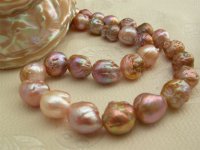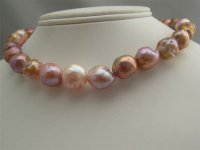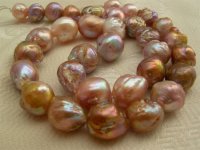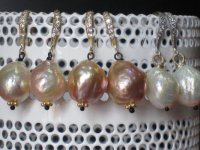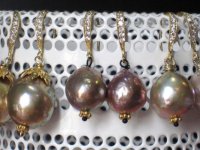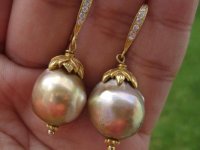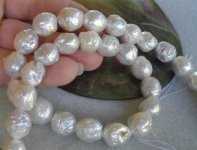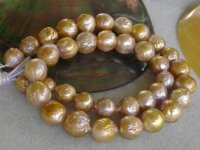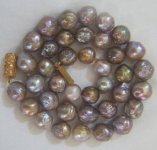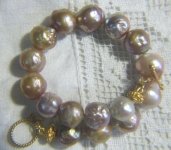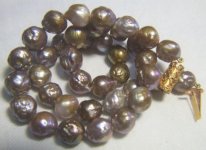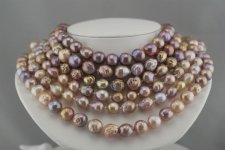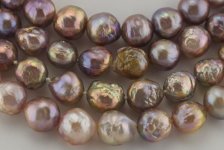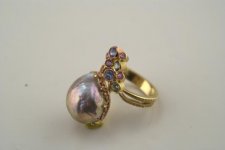You are using an out of date browser. It may not display this or other websites correctly.
You should upgrade or use an alternative browser.
You should upgrade or use an alternative browser.
Japanese Kasumi vs. Chinese "Look-a-likes"
- Thread starter mausketeer
- Start date
mausketeer
New Member
- Joined
- Jul 7, 2008
- Messages
- 474
Adeline Leigh
New Member
- Joined
- Oct 1, 2011
- Messages
- 722
Can I, can I, oh can I butt in here?
You are really men and women after my own heart. Not having deep enough pockets for Japanese kasumis, when I spotted these in HK I leapt for various strands and a whole tonal range of colours (the heavily pitted pondslimes, coppers and greens aren't pictured) of these wrinkly beauties. The very evening I arrived back I had to make several pairs immediately to my immense satisfaction. My husband and friends thought it so weird that I had forsaken my other pearls (read: to them, nicer) but it takes real pearl lovers to love all sorts especially the weird and interestingly textured ones!
And Jodie, we are kindred spirits. I bought some of those giants (18mm!) off that same vendor too and they are splendidly oil-slick (though smooth skinned) and mauvy-golden-lavendered (mouthful, I know!) hued. The vendor's pics make them appear darker than pictured but they are lighter in person. Just for you, one more close up shot (crappy, I know, am still trying)! But go get them, girl!
Having said all this, one day before I die, I swear (out of husband's earshot) I WILL own some kasumis and I do mean the real deal!
You are really men and women after my own heart. Not having deep enough pockets for Japanese kasumis, when I spotted these in HK I leapt for various strands and a whole tonal range of colours (the heavily pitted pondslimes, coppers and greens aren't pictured) of these wrinkly beauties. The very evening I arrived back I had to make several pairs immediately to my immense satisfaction. My husband and friends thought it so weird that I had forsaken my other pearls (read: to them, nicer) but it takes real pearl lovers to love all sorts especially the weird and interestingly textured ones!
And Jodie, we are kindred spirits. I bought some of those giants (18mm!) off that same vendor too and they are splendidly oil-slick (though smooth skinned) and mauvy-golden-lavendered (mouthful, I know!) hued. The vendor's pics make them appear darker than pictured but they are lighter in person. Just for you, one more close up shot (crappy, I know, am still trying)! But go get them, girl!
Having said all this, one day before I die, I swear (out of husband's earshot) I WILL own some kasumis and I do mean the real deal!
Attachments
mausketeer
New Member
- Joined
- Jul 7, 2008
- Messages
- 474
Yes! Everyone with Kasumi's and Chinese freshwaters, raise your hands! (and post your photos please!)
Adeline, those earrings are divine! And yes, that last pair is wonderful - those caps are amazing!
I'm glad someone else bought some from the same vendor (the hame of the women who sold me mine is Janet. Funny how you can tell the same pearls just from the photos!). And thanks, I had wondered exactly how dark they were as some of the photos were a bit lighter than others (but dark purple would have suited me just fine as well!) I was looking at some spacer beads for them as I think the strand may be a bit short without them (and I like the look). I think rose gold would be nice. Was thinking of some daisy bali beads but then I saw these rough cut ones and thought they suited the pearls a bit more...... I think I prefer the rounder ones to the square...... but I do like how "raw" the square ones look. I used them in silver on another necklace I have.
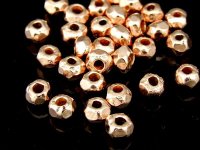
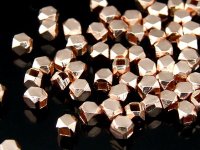
Adeline, those earrings are divine! And yes, that last pair is wonderful - those caps are amazing!
I'm glad someone else bought some from the same vendor (the hame of the women who sold me mine is Janet. Funny how you can tell the same pearls just from the photos!). And thanks, I had wondered exactly how dark they were as some of the photos were a bit lighter than others (but dark purple would have suited me just fine as well!) I was looking at some spacer beads for them as I think the strand may be a bit short without them (and I like the look). I think rose gold would be nice. Was thinking of some daisy bali beads but then I saw these rough cut ones and thought they suited the pearls a bit more...... I think I prefer the rounder ones to the square...... but I do like how "raw" the square ones look. I used them in silver on another necklace I have.


Last edited:
mausketeer
New Member
- Joined
- Jul 7, 2008
- Messages
- 474
Having said all this, one day before I die, I swear (out of husband's earshot) I WILL own some kasumis and I do mean the real deal!
I hear you! They're certainly on MY list....... But what about Sea of Cortez? Those are MY "lottery pearls". lol
Adeline Leigh
New Member
- Joined
- Oct 1, 2011
- Messages
- 722
Jodie: We have MANY lottery pearls between us; now we just need divine intervention to win Powerball and perhaps just buy a single ticket first! And yes, Lady J did sell me those too 
Jeremy: Thank U.. It means so much to me; how about biting now and stocking these oddball pearls? I still have my eye on your souffles and metallic bead nuke baroques and am wishing Christmas is upon us now...
Pattye: I can hardly wait to see the designs you cobble up; you of pearl guru greatness!
Jeremy: Thank U.. It means so much to me; how about biting now and stocking these oddball pearls? I still have my eye on your souffles and metallic bead nuke baroques and am wishing Christmas is upon us now...
Pattye: I can hardly wait to see the designs you cobble up; you of pearl guru greatness!
If anyone is looking for strands rather than necklaces they should check our rainbowislandpearls. Inger has a few strands at the moment but pairs of the Chinese Wrinkly Kasumi like pearls. She is in my opinion the best and most honest seller on eBay. Have a look at these plus others she has listed. Might even have some more not listed yet.
http://www.ebay.com/itm/RARE-FIND-I...ted-Pearl-Strand-CHINESE-KASUMI-/290609254841 $281
http://www.ebay.com/itm/RARE-FIND-G...ted-Pearl-Strand-CHINESE-KASUMI-/310344912869 $266
http://www.ebay.com/itm/RARE-FIND-G...ted-Pearl-Strand-CHINESE-KASUMI-/290609269800 $281
These are some of Ingers. I know she has had other shades as well.
Dawn - Bodecia
http://stores.ebay.com/Dawns-Designer-Collections
Natural pearl collector and all round pearl lover
http://www.ebay.com/itm/RARE-FIND-I...ted-Pearl-Strand-CHINESE-KASUMI-/290609254841 $281
http://www.ebay.com/itm/RARE-FIND-G...ted-Pearl-Strand-CHINESE-KASUMI-/310344912869 $266
http://www.ebay.com/itm/RARE-FIND-G...ted-Pearl-Strand-CHINESE-KASUMI-/290609269800 $281
These are some of Ingers. I know she has had other shades as well.
Dawn - Bodecia
http://stores.ebay.com/Dawns-Designer-Collections
Natural pearl collector and all round pearl lover
Attachments
Adeline Leigh
New Member
- Joined
- Oct 1, 2011
- Messages
- 722
Yup, I vouch for Inger too. Bought from her too before I reaquainted myself with HK. She's the loveliest lady...
Photos of both Chinese Wrinklies & Japanese Kasumi pearls
Photos of both Chinese Wrinklies & Japanese Kasumi pearls
Okay here are some photos. I do have another strand I need to take a photo of and I will also take a photo of Japanese Kasumi and the Chinese Wrinklies side by side so you can compare. I find them equally beautiful. Have to wait for my camera batteries to finish recharging. Takes so long.
Remember for quality with the Chinese and a great price check out rainbowislandpearls on eBay who has them as strands and loose. I only have made up jewellery.
So as for the pearls - which is which. Can you really tell without peeking at my site!!
Enjoy.
Dawn - Bodecia
http://stores.ebay.com/Dawns-Designer-Collections
Natural pearl collector and all round pearl lover
Photos of both Chinese Wrinklies & Japanese Kasumi pearls
Okay here are some photos. I do have another strand I need to take a photo of and I will also take a photo of Japanese Kasumi and the Chinese Wrinklies side by side so you can compare. I find them equally beautiful. Have to wait for my camera batteries to finish recharging. Takes so long.
Remember for quality with the Chinese and a great price check out rainbowislandpearls on eBay who has them as strands and loose. I only have made up jewellery.
So as for the pearls - which is which. Can you really tell without peeking at my site!!
Enjoy.
Dawn - Bodecia
http://stores.ebay.com/Dawns-Designer-Collections
Natural pearl collector and all round pearl lover
Attachments
lisa c
Perpetual Pearl Student
- Joined
- Jun 28, 2009
- Messages
- 3,600
Hi Dawn,
Am I correct in remembering the Chinese look gold-dusted? That would be upper right photo.
Bottom and top left, Kasumi?
That's all I'm going to hazard, and I'm glad I'm not putting money on the table. I don't know enough. I'm just playing.
Am I correct in remembering the Chinese look gold-dusted? That would be upper right photo.
Bottom and top left, Kasumi?
That's all I'm going to hazard, and I'm glad I'm not putting money on the table. I don't know enough. I'm just playing.
I hear you! They're certainly on MY list....... But what about Sea of Cortez? Those are MY "lottery pearls". lol
Lol- great minds! Douglas has featured some truly spectacular pearls here, I've been dreaming mostly in silence of owning a few of my own one day...
Adeline- I love your earrings! The little golden details at the bottoms are a great way to light up the pearls and play with their metallic overtones.
pearlescence
purveyor of pearls UK/EU
- Joined
- Aug 18, 2007
- Messages
- 4,120
If we agree that the kasumi-ish pearls are a remarkable resemblance to the real kasumi, then can I now throw these pearls into the mix. I didn't know what I had until I got them back here and happened to put a strand down next to a strand of white south seas then had to look twice to tell them apart...
http://www.pearlescence.co.uk/product_info.php/cPath/104_175/products_id/3184
the colour and look of the nacre are very close to wss. the flaws on the nacre are typical of freshwater and not the sort of raindrops into creamy mud sort of splots you get on ss but unless you get close enough to see that, they are sooooooooooooo close
http://www.pearlescence.co.uk/product_info.php/cPath/104_175/products_id/3184
the colour and look of the nacre are very close to wss. the flaws on the nacre are typical of freshwater and not the sort of raindrops into creamy mud sort of splots you get on ss but unless you get close enough to see that, they are sooooooooooooo close
mausketeer
New Member
- Joined
- Jul 7, 2008
- Messages
- 474
Dawn - I must be getting better at this whole "pearl thing" because I already had "Rainbow Island Pearls" saved as a favorite seller on my Ebay! Yes, saw her strands but I'm really in love with purple so didn't buy from her........ same with Wendy's....... I saw a lot of amazing purple strands on Katherine Cardellini's website too but her prices were a bit beyond my reach I'm afraid......
Dawn, I'm going to guess that the strand with the gold barrel clasp are the Kasumi's and the blue enamel clasp is Chinese? But man, yeah, it's so close it really is a guess....... (and of course I don't have ANY real world experience - yet!) I love them all! Obviously you love purple too! lol
Wendy, it's amazing how smooth they're getting, isn't it? Won't be able to tell them apart pretty soon......
- Jodie -
Dawn, I'm going to guess that the strand with the gold barrel clasp are the Kasumi's and the blue enamel clasp is Chinese? But man, yeah, it's so close it really is a guess....... (and of course I don't have ANY real world experience - yet!) I love them all! Obviously you love purple too! lol
Wendy, it's amazing how smooth they're getting, isn't it? Won't be able to tell them apart pretty soon......
- Jodie -
kojimapearl
Well-known member
- Joined
- Feb 13, 2007
- Messages
- 445
chiming in from Hong Kong
chiming in from Hong Kong
Hi everyone.. very interesting thread! (and thank you to Karin for calling me in here). I have just this morning landed in Hong Kong on a buying trip and I am bit foggy right now, but here are 4 photos of JAPAN KASUMI pearls.
There are so many things I want to write here, I am not sure where to start... I will do my best to keep it concise.
1. Japan Kasumi pearls are "rare" because there are only 3 farmers who produce them. They rank among a very short list of pearls that may actually gain value with age.... because their very existence is a miracle and their future production a yearly tenuous situation. (please include Sea of Cortez, and Kamoka pearls in that very short list!)
2. Yes they look very very similar to Chinese pearls with the same characteristics, and same natural color range. I can say that after many years of dealing with both Chinese in body nucleated "ripple" surface pearls and nearly two decades of dealing in Japanese Kasumi pearls.. I can tell which are which from our own stock.. but I must add, that you could probably find individual pearls that could fool me.
3. Yes Chinese pearls do run about up to a tenth of the price.
4. What makes Japan Kasumi pearls so dear is their provenance... if you can afford it and you value the mystique.. then only buy them from reputable dealers.
5. From the ADVENT of Japanese Akoya production, the tiny non nucleated pearls that came out were referred to as "keshi" (which means poppyseed in Japanese, AND the key part of the definition is that it is a non nucleated pearl!~), because these pearls were mostly very very tiny. Many decades later when Chinese fresh water pearl producers began to harvest unusual asymmetrical shapes.. they fished around for a name to call these "funny" looking pearls... well the pearl market was already well versed in the term keshi and it's association with baroque (sometimes spikey) shapes.. so they started calling their Chinese pearls "keshi".. this is a misnomer, and altogether a different thread, but I mention it because it is the same "branding" phenomenon that is leading to the confusion between Japanese and Chinese Kasumi pearls. In most cases (and yes I am being generous) pearl dealers (especially at the largest wholesale levels) will not aim to be dishonest when selling their Chinese pearls as Kasumi, they are incorrect, but they are not trying to mislead.. it may just be what they were called when they bought them.
6. In an effort to clear this up before it becomes pandemic.. we adhere to Japan Kasumi pearls being only those actually farmed in the vicinity of Lake Kasumi ga Ura, Japan under the care of 3 farmers! and that if we must.. we can all call everything else that looks similar Chinese Kasumi. I am personally still on the fence about that, but Fuji insists that it's the best way (or rather that it's inevitable) .. lol.. I will let him win again.. anyhow people still use "pondslime" and I fought that for YEARS!
7. I just heard from the farmers in Japan yesterday, and we are hoping to see the next harvest in January. It has been the toughest year imaginable for them and despite which pearls you favor over the others... I hope that you will all continue to keep them in your prayers, as they like us.. love pearls above most things!
I really must use the last bits of my clear thinking to go and shop, but being as though I am here in Hong Kong, I will post some new photos of the Chinese pearls I find that look as close as possible.
(I love that part about : when the boyfriend wears pearls.. he can have an opinion, and I agree Inger is top notch
Beautiful earrings Adeline!)
Cheers, Sarah
chiming in from Hong Kong
Hi everyone.. very interesting thread! (and thank you to Karin for calling me in here). I have just this morning landed in Hong Kong on a buying trip and I am bit foggy right now, but here are 4 photos of JAPAN KASUMI pearls.
There are so many things I want to write here, I am not sure where to start... I will do my best to keep it concise.
1. Japan Kasumi pearls are "rare" because there are only 3 farmers who produce them. They rank among a very short list of pearls that may actually gain value with age.... because their very existence is a miracle and their future production a yearly tenuous situation. (please include Sea of Cortez, and Kamoka pearls in that very short list!)
2. Yes they look very very similar to Chinese pearls with the same characteristics, and same natural color range. I can say that after many years of dealing with both Chinese in body nucleated "ripple" surface pearls and nearly two decades of dealing in Japanese Kasumi pearls.. I can tell which are which from our own stock.. but I must add, that you could probably find individual pearls that could fool me.
3. Yes Chinese pearls do run about up to a tenth of the price.
4. What makes Japan Kasumi pearls so dear is their provenance... if you can afford it and you value the mystique.. then only buy them from reputable dealers.
5. From the ADVENT of Japanese Akoya production, the tiny non nucleated pearls that came out were referred to as "keshi" (which means poppyseed in Japanese, AND the key part of the definition is that it is a non nucleated pearl!~), because these pearls were mostly very very tiny. Many decades later when Chinese fresh water pearl producers began to harvest unusual asymmetrical shapes.. they fished around for a name to call these "funny" looking pearls... well the pearl market was already well versed in the term keshi and it's association with baroque (sometimes spikey) shapes.. so they started calling their Chinese pearls "keshi".. this is a misnomer, and altogether a different thread, but I mention it because it is the same "branding" phenomenon that is leading to the confusion between Japanese and Chinese Kasumi pearls. In most cases (and yes I am being generous) pearl dealers (especially at the largest wholesale levels) will not aim to be dishonest when selling their Chinese pearls as Kasumi, they are incorrect, but they are not trying to mislead.. it may just be what they were called when they bought them.
6. In an effort to clear this up before it becomes pandemic.. we adhere to Japan Kasumi pearls being only those actually farmed in the vicinity of Lake Kasumi ga Ura, Japan under the care of 3 farmers! and that if we must.. we can all call everything else that looks similar Chinese Kasumi. I am personally still on the fence about that, but Fuji insists that it's the best way (or rather that it's inevitable) .. lol.. I will let him win again.. anyhow people still use "pondslime" and I fought that for YEARS!
7. I just heard from the farmers in Japan yesterday, and we are hoping to see the next harvest in January. It has been the toughest year imaginable for them and despite which pearls you favor over the others... I hope that you will all continue to keep them in your prayers, as they like us.. love pearls above most things!
I really must use the last bits of my clear thinking to go and shop, but being as though I am here in Hong Kong, I will post some new photos of the Chinese pearls I find that look as close as possible.
(I love that part about : when the boyfriend wears pearls.. he can have an opinion, and I agree Inger is top notch
Beautiful earrings Adeline!)
Cheers, Sarah
Attachments
Adeline Leigh
New Member
- Joined
- Oct 1, 2011
- Messages
- 722
GASP, Sarah... (sharp intake of air and be still that beating heart), am dying for some of the purple ones!
As many of us attest, those mauve ones are true attention-grabbers! Am so glad I have formal membership to PG; now you know what I have been up to with those that I have bought from you.
PS: Love THAT ring; the gemstone cluster really complements the hues in the pearl. LIKE!
As many of us attest, those mauve ones are true attention-grabbers! Am so glad I have formal membership to PG; now you know what I have been up to with those that I have bought from you.
PS: Love THAT ring; the gemstone cluster really complements the hues in the pearl. LIKE!
Last edited:
Similar threads
- Replies
- 24
- Views
- 8K
- Replies
- 3
- Views
- 852
- Replies
- 4
- Views
- 6K

